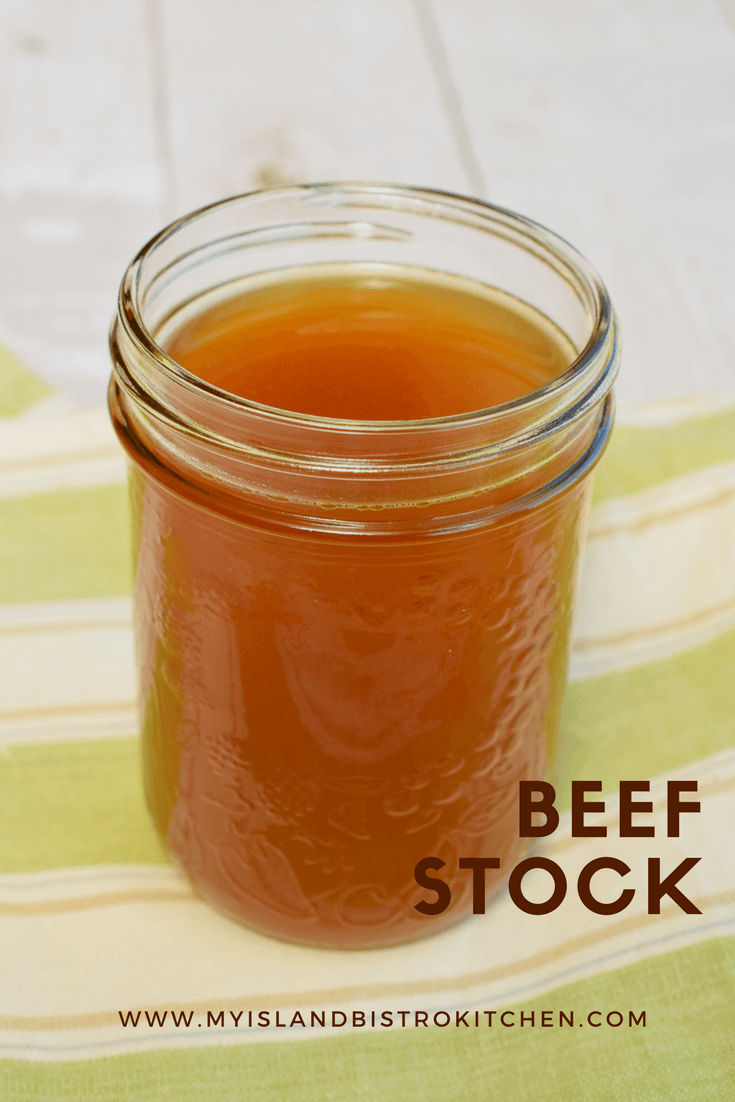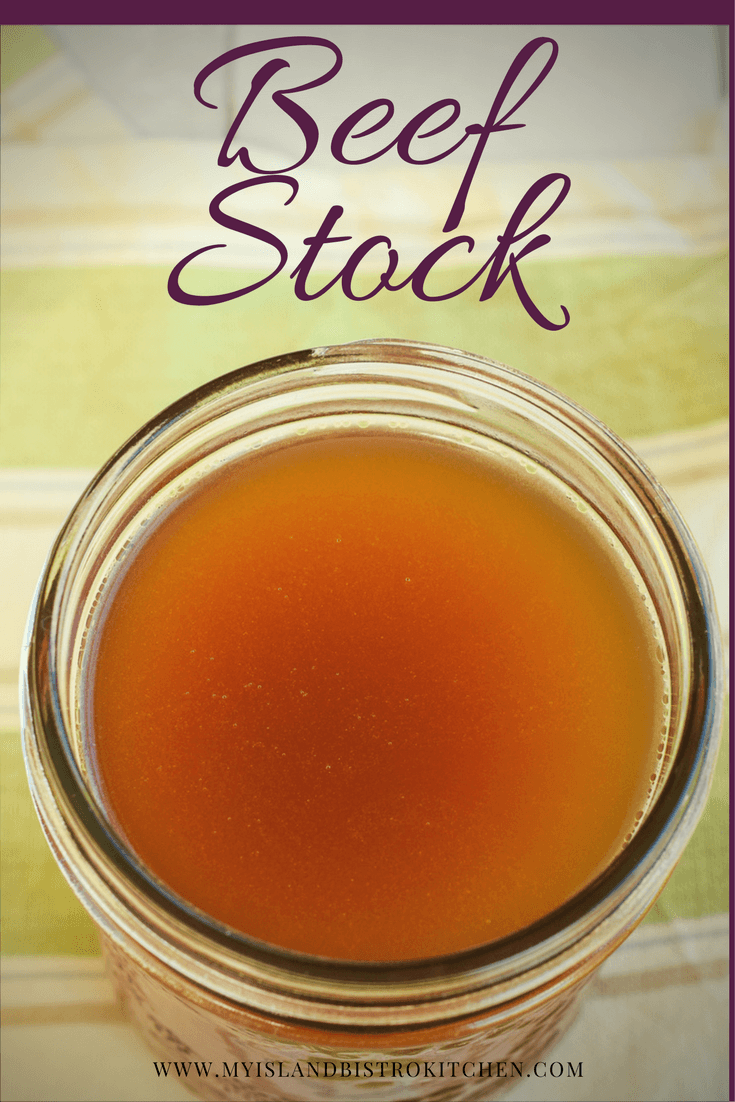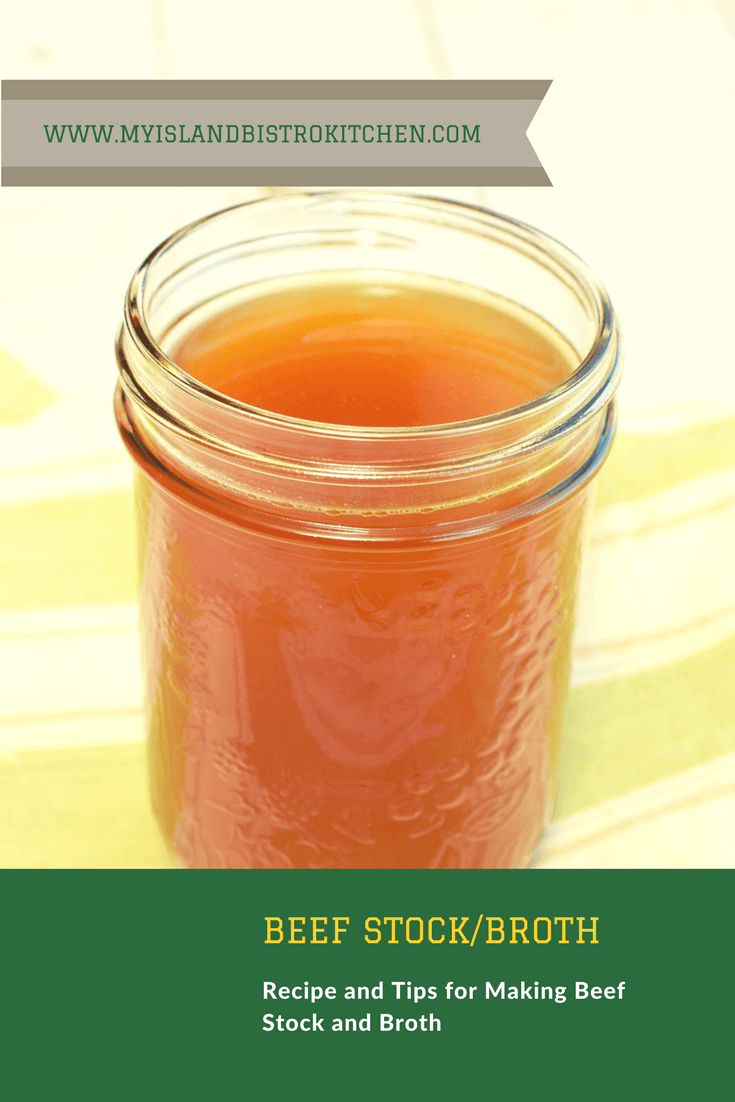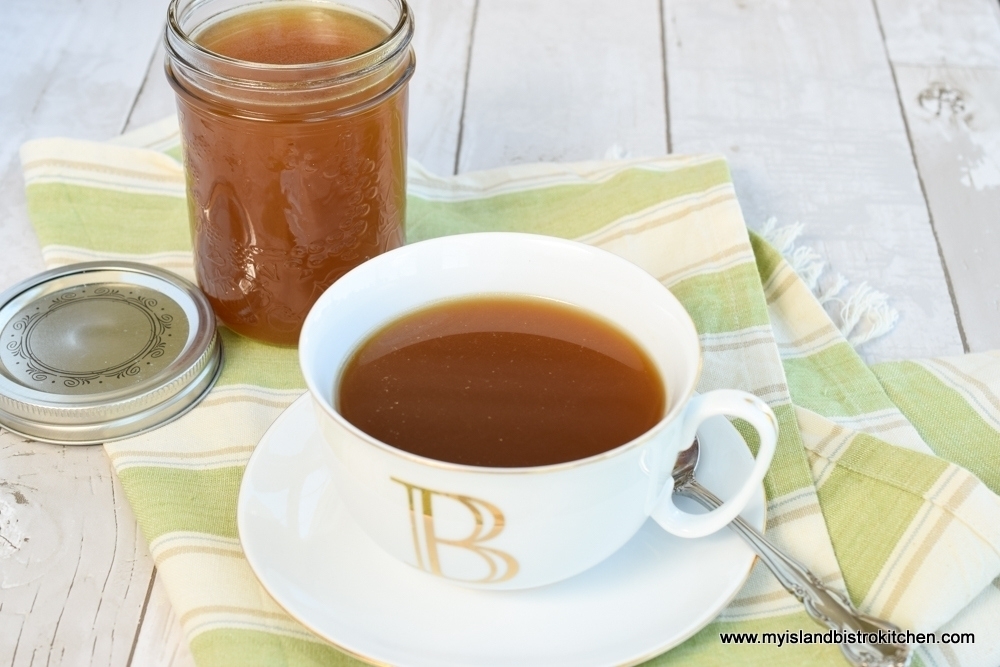
Beef stock and beef broth are terms often used interchangeably. However, there is actually a difference between the two. True beef stock is made principally with bones and water and little to no seasoning. It typically simmers for hours on the stove. Beef stock is nutrient dense, protein rich, and a good source of minerals and gelatin. Traditional beef broth, on the other hand, is usually made mainly with meat (though some bones may be included) and it often has additional flavorings (from vegetables, herbs, and spices) added to it. Beef broth typically simmers for less time than a true beef stock and is, therefore, a lighter product.
It seems the theory is that stock, made from the bones, is more pure and versatile than broth. This is because the unseasoned stock can be used in more dishes in which seasoning can then be added, unique to each dish as it is made. I actually like the soup, sauce, or casserole base (i.e., the stock/broth) to already have some seasoning in it to start with and I don’t experience any issues with my already-seasoned stock/broth in any recipe I am making. I like the extra flavour boost the seasoned stock/broth gives to dishes. So, regardless what it is technically called, what follows is my recipe for beef stock/broth (or a combination or modification thereof). Plan to make this on a day when you will be home for the day as this stock/broth will take 6-8 hours to simmer slowly.
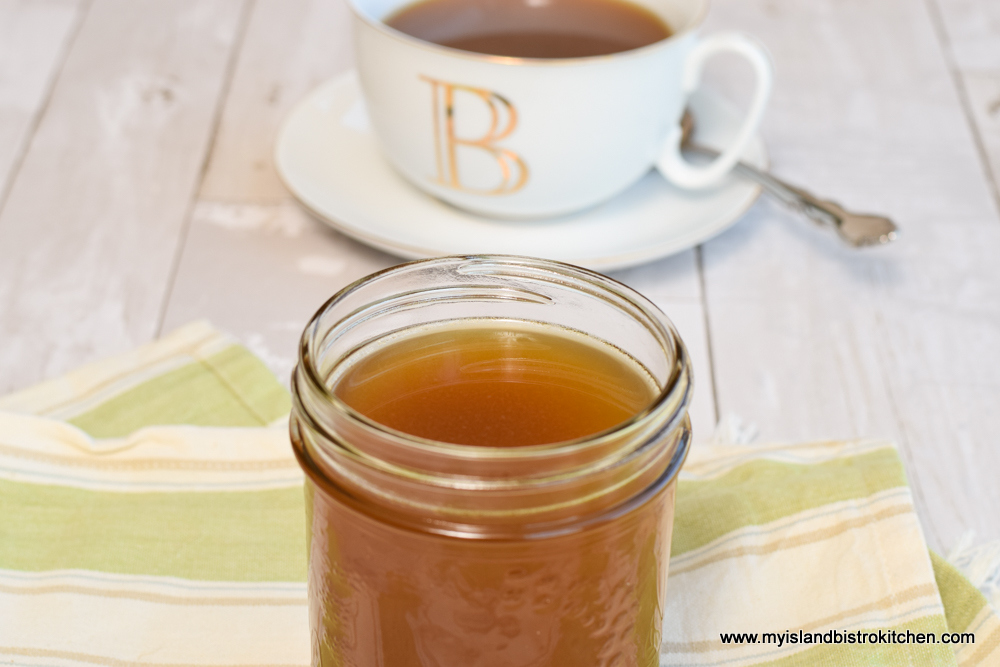
A good stock/broth is a handy staple to have on hand in the cook’s kitchen (or freezer). Of course, if it is made as a broth with some seasonings, it can be used as a drink and is particularly useful in situations where one must follow a clear liquid diet. But, the stock/broth can be used as the base for soups, sauces, braised dishes, and gravies and it can also be used when called for in a host of recipes and other dishes. With a homemade stock/broth, you know what is in it, there are no preservatives, and the amount of salt can be controlled. I find that a lot of commercially-made stocks and broths are way too salty for my taste.
So, about 5 pounds of meaty bones with marrow from the local butcher will be needed for my recipe. By “meaty bones”, I am referring to bones that still have some meat on them. In fact, I like to include a couple of bones that have a substantial amount of meat on them as this, in my opinion, deepens the flavour of the stock/broth. Marrow is the fatty gelatin-like matter found in the cavity of large bones. If you tell your butcher you are making stock/broth, he or she will know what product you are looking for – i.e., beef bones with marrow – ribs, shanks, knuckle bones, and so forth. I call my butcher a couple of days in advance to ensure that the butcher shop will have the right product and amount set aside for me and I always ask that the meaty bones be cut into 2” – 3” thick chunks so they are easier to handle in both the roasting and simmering processes. The photo below shows a sampling of the bones/meat I typically use in my stock/broth.

I like lots of deep flavor and color in my beef stock/broth. One way to get this is to roast the meaty bones. The roasting process will caramelize the meaty bones and this will yield a rich brown-colored stock/broth. Roast the bones at a high temperature (450°F) for about 30 minutes then brush some tomato paste over them and return them to the oven to roast for about 30 minutes longer.
Because I like lots of flavour in my stock/broth, I add some aromatic and flavourful vegetables – carrots, leek, parsnips, onion, celery, mushrooms, and a hefty dose of garlic. There is no need to peel the vegetables (except for the rutabaga that often has a wax coating). Just make sure they are very well washed. You want all the flavour and colour you can get from the vegetables, some of which is contained in the skins/peelings which will later be discarded anyway once the stock/broth is cooked and strained.
Celery is a big flavour agent in this stock/broth and that’s why, in addition to the three stalks of celery called for in the recipe, the celery leaves and the base of the three stalks are used to intensify the flavour. Any kind of mushrooms can be used in the stock/broth. Portobellos would be my first choice because of their earthy flavour and deep colour which will contribute to the colour of the stock/broth. I have, however, made great stock with the simple white button mushrooms which, of course, are more economical than Portobellos. Toss the vegetables with olive oil and add them to the roaster during the last 30 minutes of the roasting bones. It’s important to ensure these don’t burn or char so keep an eye on them and turn the veggies, if necessary, as they roast.
Once the bones and veggies are roasted, transfer them to a large stock pot. Don’t discard all those lovely brown bits and scrapings left in the roasting pan! Simply add a small amount of water to the pan (or you can use a bit of red wine, if you wish), place the roaster over medium heat, and scrape those bits up and transfer them to the stockpot, too. There is a lot of valuable flavour in those scrapings, too good to lose.
Fresh herbs can, of course, be used in this recipe but I have given amounts for dried herbs because we don’t all have access to quality fresh herbs year-round. Even though this stock will be strained, I still like to gather up all the herbs and spices into a bouquet garni because it corrals them and keeps the stock cleaner. To make the bouquet garni, cut an 8” square of double layer of cheesecloth, place the herbs and spices in the center, gather up the cheesecloth, and tie it with string. Add this lovely aromatic sachet to the stock pot. As the stock/broth simmers, it will be infused by the herbs and spices. Add the cold water, vinegar, bay leaves, and sea salt. The vinegar will draw the gelatin, nutrients, and minerals from the bones through the slow simmering process. Because only a small amount of vinegar is used, it will not leave a negative taste to the stock/broth.
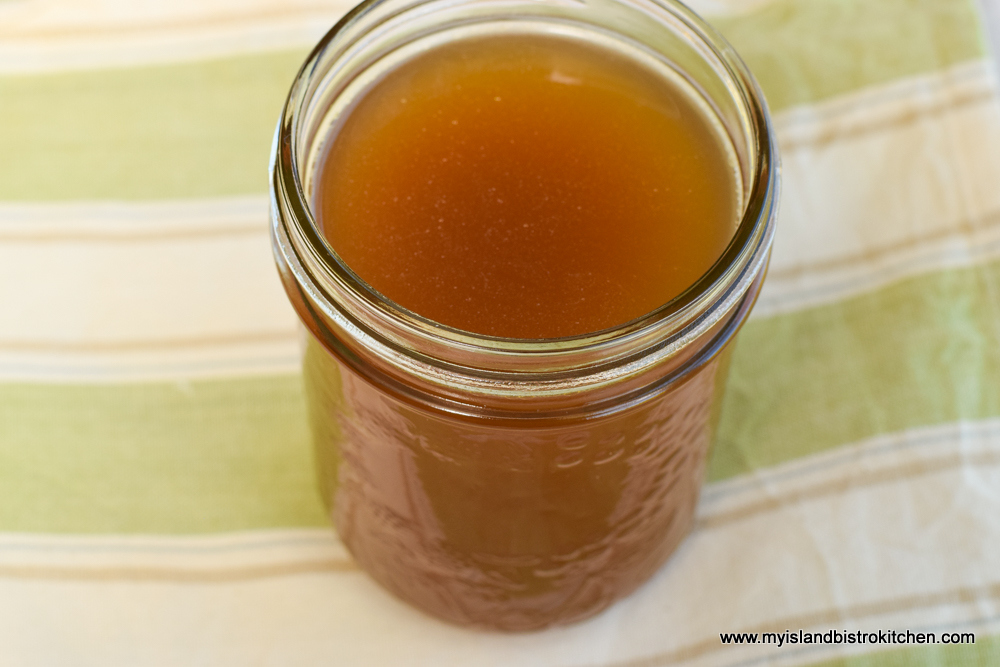
Bring the ingredients almost, but not quite, to the boiling point over medium-high heat. It’s critical that this stock NEVER boil – that will make it cloudy and the look you’re aiming for is a translucent liquid. Reduce the heat to a low simmer. The temperature of the liquid should reach and stay around the 200°F point. A candy thermometer is useful to verify the heat from time to time as the stock/broth simmers. If the temperature of the liquid dips below 200°F, simply increase the heat just a bit to bring the temperature back up to the simmering point. If it exceeds 200°F, drop the heat back. It’s okay if you see tiny bubbles forming but they should not break the surface of the liquid. The other tip to a translucent stock/broth is not to stir it as it is simmering. This will stir everything up and can cause clouding to occur, resulting in a murky stock/broth. While a cloudy broth will not affect its flavour, a translucent broth is more eye appealing.
As the mixture is simmering, you will notice some fat from the bones rising to the surface. Periodically take a large spoon and skim this fat away and discard it. Don’t cover the stockpot while the stock/broth is simmering as it is more difficult to keep the liquid at the simmering point if it is covered. Also, some reduction of the liquid is required in order to achieve desired flavour. If you find that too much of the stock/broth is evaporating too quickly, reduce the heat and add a bit more cold water to ensure all the ingredients are submerged in the liquid. However, be cautious about adding too much water as it will dilute the flavour of the stock/broth.
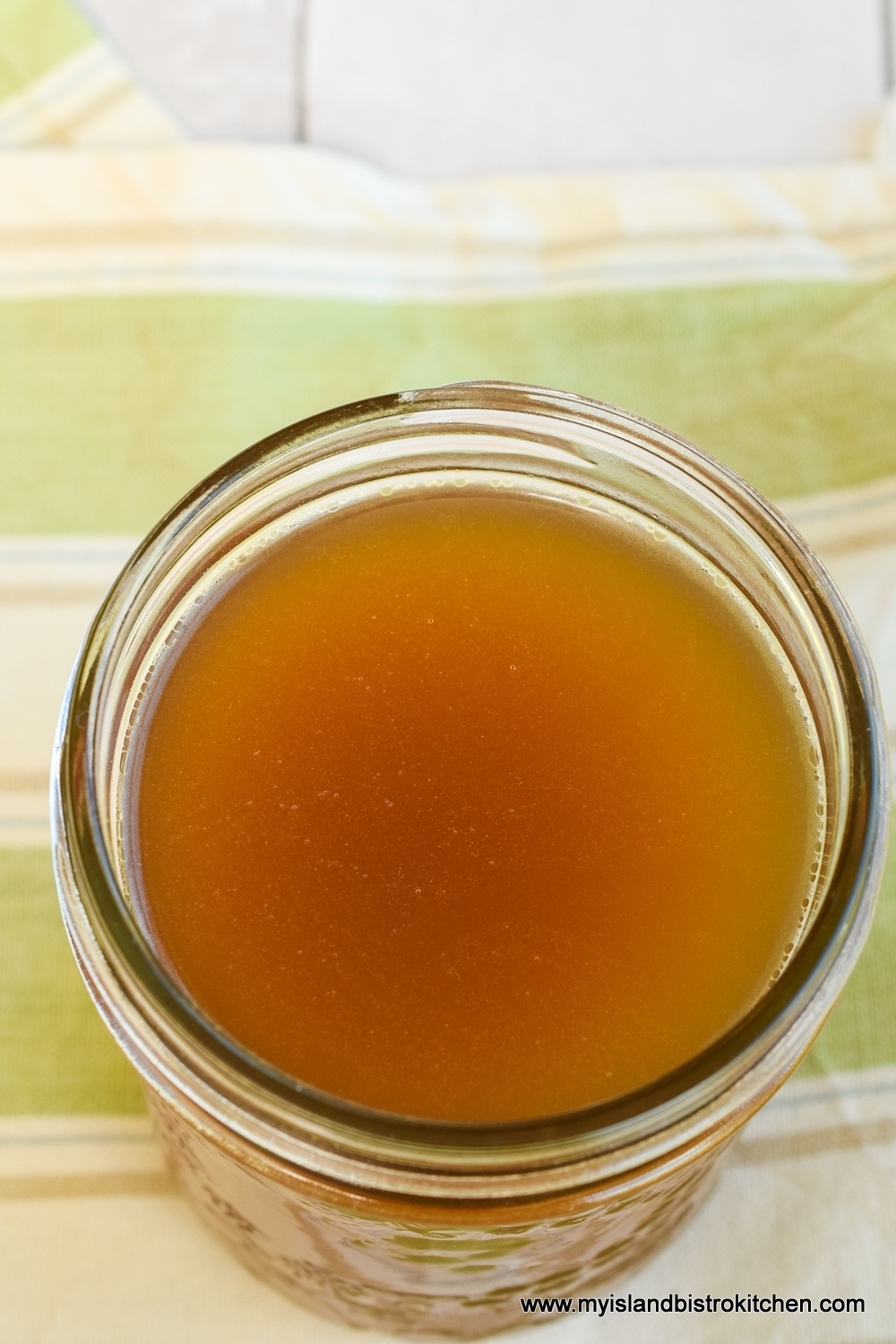
Once the stock/broth has simmered for 6-8 hours, remove it from the heat and strain it. To do this, line a large colander with a double layer of damp cheesecloth. Place the colander over a clean stock pot and pour the stock/broth into the colander. Discard the bones, vegetables, and bouquet garni. Place the stockpot containing the strained stock/broth in a large sink filled with ice water to cool it quickly. Skim off any further solidified fat as the stock/broth cools. If you are super particular about having a totally clear stock/broth, free of all impurities, I recommend straining it twice through a colander lined with damp cheesecloth. The stock/broth in the photos in this posting were strained once. Some tiny impurities are visible. They don’t bother me but a second straining of the stock/broth would remove them. Place the strained stock in the refrigerator to chill completely then remove any remaining solidified fat. For more intense flavored stock/broth, it can be placed back on the stove at medium-low heat and reduced to one-half, yielding a stronger, more concentrated flavour but there will obviously be less quantity.
So, apart from the necessity to use the right ingredients in the stock/broth, the three big tips I have for making a clear, high quality stock/broth are: 1) Don’t boil it; 2) Don’t stir it; and 3) Don’t cover it while it simmers. Basically, put the ingredients in a large stockpot, get the liquid to the simmering point and let it do its thing.
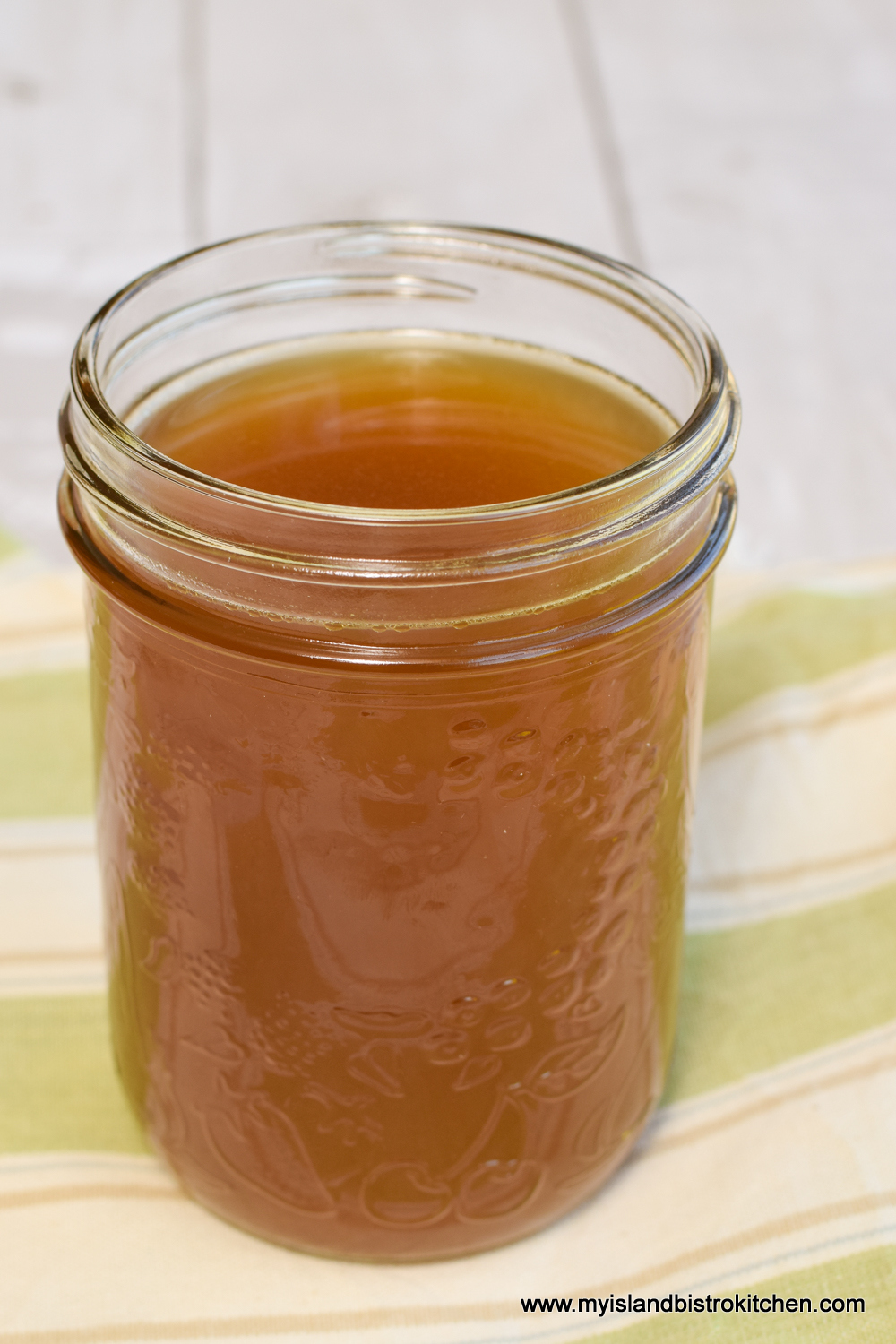
This stock/broth will keep in the refrigerator for up to three days or it can be frozen, at this point, in containers of desired size. I usually freeze and label mine in different quantities based on what recipe I intend using it in. I will often freeze some stock/broth in ice cube containers and use them for flavoring dishes, like rice or steamed vegetables, where smaller amounts may be needed. So, regardless whether the ingredients and method used in this recipe are technically a “broth” or a “stock”, I use this tasty product in any recipe calling for either beef stock or beef broth.
[Printable recipe follows at end of posting]
Homemade Beef Stock/Broth
Ingredients:
5 lbs meaty beef bones with marrow (shank, ribs, knuckle bones)
Olive oil
1 – 5 oz/156ml can tomato paste
2 large carrots, unpeeled and halved, cut into 3” chunks
1 large leek, light and white parts only, halved
2 parsnips, unpeeled, cut into 2” chunks
1 large onion, unpeeled, halved
11 oz rutabaga, peeled, cut into ½” slices and halved
1 head garlic (containing apx. 9-10 cloves)
3 large celery ribs (with leaves and base of stalks included), cut into 3” chunks
6 oz mushrooms, halved
1 tbsp dried parsley
1½ tsp mixed peppercorns
1 tsp dried thyme
1 tsp dried oregano
1 tsp dried rosemary
1 tsp dried basil
6 whole allspice
4 whole cloves
12 cups cold water
1½ tbsp cider vinegar
2 bay leaves
1½ tsp fine sea salt
Method:
Preheat oven to 450°F. Grease large roasting pan. In large bowl, toss meaty bones with olive oil to lightly coat. Place bones in roaster and roast for 30 minutes.
Place carrots, leek, parsnips, onion, rutabaga, garlic, celery, and mushrooms in a large bowl and add enough olive oil to lightly coat.
Remove bones from oven, turn, and brush them with tomato paste. Add the olive-oil coated vegetables to the roasting pan and return the roaster to the oven. Roast for another 30 minutes, turning the vegetables once or twice to ensure they do not burn. Transfer roasted bones and vegetables to a large stockpot. Add a small amount of water (or a bit of red wine) to roasting pan, place it over medium heat, and stir scrapings left from the roasting process. Pour into stock pot with the bones and vegetables.
Using a small 8” square of double cheese cloth, gather the herbs and spices together in the center and tie up cheesecloth to make a bouquet garni. Drop the sachet in to the stock pot. Add the cold water, vinegar, bay leaves, and sea salt.
Bring mixture to just below the boiling point over medium high heat. DO NOT BOIL. Reduce heat to a low simmer (liquid temperature should reach and remain around the 200°F point) and let stock simmer, uncovered, for 6-8 hours. If liquid evaporates too much and too quickly, reduce the heat and add a bit more water (e.g., 1 cup or so). Periodically, skim the fat, as it forms, from the surface of the stock as it simmers. Do not stir mixture as it simmers as this may create a cloudy stock/broth.
Prepare a large colander with a double layer of damp cheesecloth. Place colander over large clean stock pot and pour the stock/broth mixture into the colander to strain it. Discard bones, vegetables, and bouquet garni. Place stockpot containing the strained stock/broth in large sink filled with ice water to cool the stock quickly. Remove and discard any solidified fat. Place strained stock in refrigerator to chill completely then remove any remaining solidified fat from the chilled stock/broth.
Use stock/broth immediately or store, covered, in refrigerator for up to 3 days. Alternatively, pour stock/broth into containers of desired size and freeze for future use.
Yield: Apx. 10 cups (depending on amount of evaporation and reduction that has occurred).
NOTE: Strained stock/broth may be reheated over medium-low heat and reduced to one-half. This will yield a stronger flavored and more concentrated product but, naturally, there will be less quantity.
Straining the stock/broth twice through a cheesecloth-lined colander will yield a clearer broth, free of any impurities.
Roasted bones combined with long, slow simmering yield a deep, rich flavoured beef stock/broth that has a multitude of uses.
Ingredients
- 5 lbs meaty beef bones with marrow (shank, ribs, knuckle bones)
- Olive oil
- 1 – 5 oz/156ml can tomato paste
- 2 large carrots, unpeeled and halved, cut into 3” chunks
- 1 large leek, light and white parts only, halved
- 2 parsnips, unpeeled, cut into 2” chunks
- 1 large onion, unpeeled, halved
- 11 oz rutabaga, peeled, cut into ½” slices and halved
- 1 head garlic (containing apx. 9-10 cloves)
- 3 large celery ribs (with leaves and head of stalks included), cut into 3” chunks
- 6 oz mushrooms, halved
- 1 tbsp dried parsley
- 1½ tsp mixed peppercorns
- 1 tsp dried thyme
- 1 tsp dried oregano
- 1 tsp dried rosemary
- 1 tsp dried basil
- 6 whole allspice
- 4 whole cloves
- 12 cups cold water
- 1½ tbsp cider vinegar
- 2 bay leaves
- 1½ tsp fine sea salt
Instructions
- Preheat oven to 450°F. Grease large roasting pan. In large bowl, toss meaty bones with olive oil to lightly coat. Place bones in roaster and roast for 30 minutes.
- Place carrots, leek, parsnips, onion, rutabaga, garlic, celery, and mushrooms in a large bowl and add enough olive oil to lightly coat.
- Remove bones from oven, turn, and brush them with tomato paste. Add the olive-oil coated vegetables to the roasting pan and return the roaster to the oven. Roast for another 30 minutes, turning the vegetables once or twice to ensure they do not burn. Transfer roasted bones and vegetables to a large stockpot. Add a small amount of water (or a bit of red wine) to roasting pan, place it over medium heat, and stir scrapings left from the roasting process. Pour into stock pot with the bones and vegetables.
- Using a small 8” square of double cheese cloth, gather the herbs and spices together and tie up cheesecloth to make a bouquet garni. Drop the sachet in to the stock pot. Add the cold water, vinegar, bay leaves, and sea salt.
- Bring mixture to just below the boiling point over medium high heat. DO NOT BOIL. Reduce heat to a low simmer (liquid temperature should reach and remain around the 200°F point) and let stock simmer, uncovered, for 6-8 hours. If liquid evaporates too much and too quickly, reduce the heat and add a bit more water (e.g., 1 cup or so). Periodically, skim the fat, as it forms, from the surface of the stock as it simmers. Do not stir mixture as it simmers as this may create a cloudy stock/broth.
- Prepare a large colander with a double layer of damp cheesecloth. Place colander over large clean stock pot and pour the stock/broth mixture into the colander to strain it. Discard bones, vegetables, and bouquet garni. Place stockpot containing the strained stock/broth in large sink filled with ice water to cool the stock quickly. Remove and discard any solidified fat. Place strained stock in refrigerator to chill completely then remove any remaining solidified fat from the chilled stock/broth.
- Use stock/broth immediately or store, covered, in refrigerator for up to 3 days. Alternatively, pour stock/broth into containers of desired size and freeze for future use.
- [Copyright My Island Bistro Kitchen]
Notes
Strained stock/broth may be reheated over medium-low heat and reduced to one-half. This will yield a stronger flavored and more concentrated product but, naturally, there will be less quantity.
Straining the stock/broth twice through cheesecloth-lined colanders will yield a clearer broth, free of any impurities.
Be sure to read the accompanying blog post to this recipe as it contains additional information and tips on making beef stock/broth.
If you have made this recipe and enjoyed it and/or wish to share it with your friends and family, please do so on social media but be sure to share the direct link to this posting from my website.
Connect with My Island Bistro Kitchen on Social Media
Join the Facebook page for My Island Bistro Kitchen: https://www.facebook.com/MyIslandBistroKitchen/
Follow “the Bistro” on “X” (formerly Twitter): https://twitter.com/PEIBistro/
See the drool-worthy gallery of mouth-watering food photos from My Island Bistro Kitchen on Instagram: https://www.instagram.com/peibistro/
Follow “the Bistro” on Pinterest at https://www.pinterest.ca/peibistro/ and pin the Pinterest-ready photo found at the end of this post to your favorite Pinterest boards.
PIN ME TO PINTEREST!
